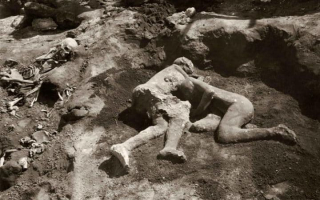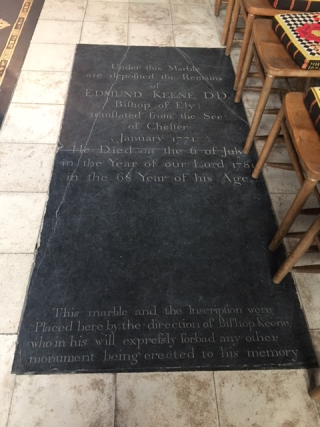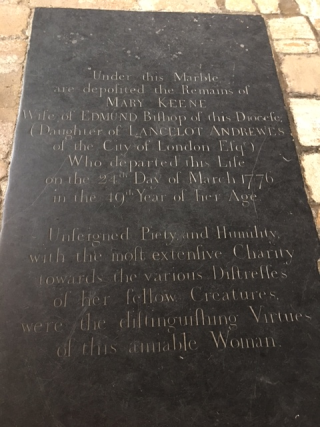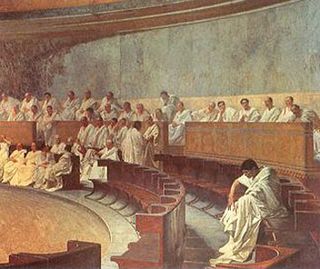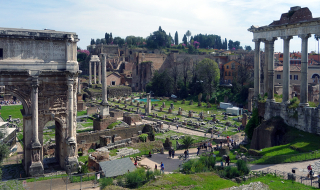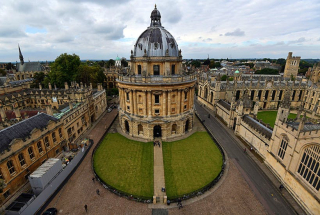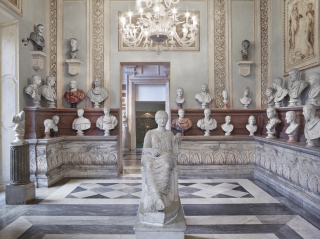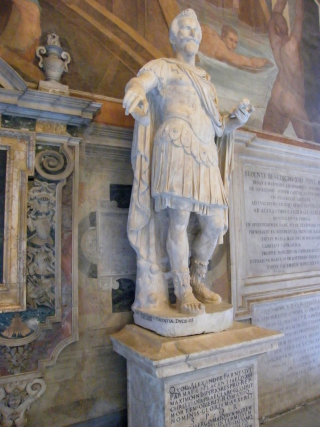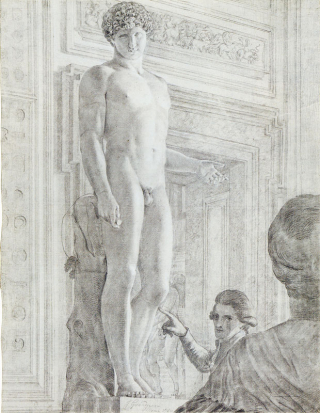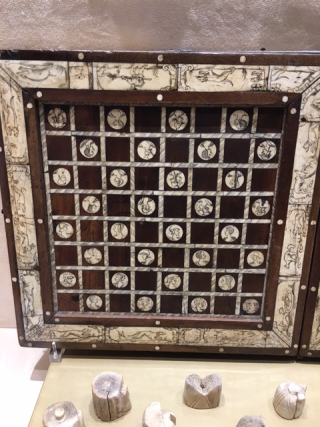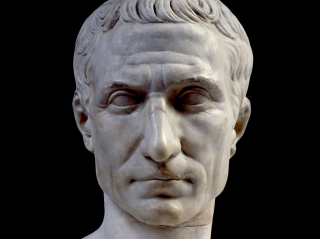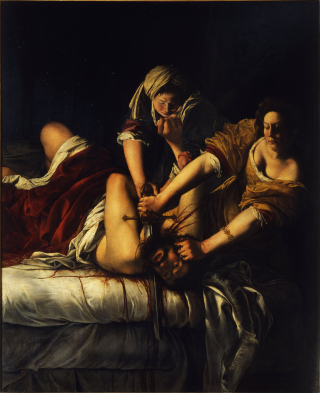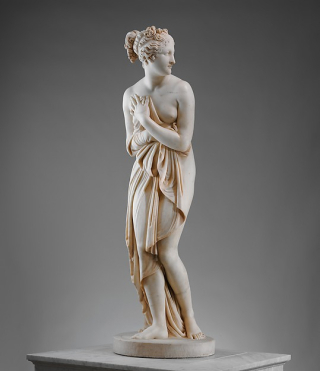Mary Beard's Blog, page 4
April 10, 2017
The conference at Lucca (56 BC)
I guess we all have to wish the G7 well in their attempts to pull together in their conference at Lucca (though in my case I hope that the pulling together will not be too hawkish). It must be said, though, that it isn���t exactly an auspicious place to be holding a ���unity��� conference. It was exactly where, in 56 BC, Julius Caesar and Crassus and Pompey tried to patch up their alliance (the so-called ���Conference of Luca���, spelled in antiquity with one c). The town has one of the longest histories of high profile summits that you could find in the West, and indeed there is a bad Syrian connection.
The back story is simple. The three men had made a deal in 60 BC to work in each others interests in the power politics of Rome in the late Republic (known now as the ���First Triumvirate���, it wasn���t anything like as official as that sounds). But by 56 the deal was fraying, partly because of Caesar���s increasing clout ��� thanks to his victories in Gaul.
So the three men met at Lucca (conveniently between Rome and Caesar���s province) to try to patch things up. And so high were the stakes that a couple of hundred of senators trooped up there too, plus no doubt the ancient equivalent of the press corps. A deal was made. Pompey and Crassus were to have the consulship in 55 BC (OK, there were elections, but they were pretty clear that they could pull it off), they were to prolong Caesar���s command in Gaul, and after his consulship Crassus was to become governor of Syria and from there to fight against the Parthians.
And so indeed it happened, for a bit. But things went wrong soon after. Crassus went to fight the Parthians in 53 BC but suffered a major defeat at Carrhae, near the Turkish/Syrian border (Crassus��� severed head was said to have been used as a prop in a Parthian performance of Euripides��� Bacchae). And Caesar and Pompey quickly moved further apart, ending up head to head in civil war in 49 BC.
So bad ancient omens from Lucca, and especially bad Syrian omens. I wonder if our Foreign Secretary is, as I write, regaling fellow delegates with stories of the First Triumvirate and the Battle of Carrhae.
(The other version: http://www.the-tls.co.uk/conference-l...)
April 8, 2017
Gays in Pompeii
There has been some really interesting recent work on the plaster casts of the victims of Pompeii. That has meant looking carefully and scientifically at whatever human remains there are still in the plaster (it was never supposed there were many), and often showing that the usual identification of these people is wildly off mark. Figures often assumed to be old men turn out to be young, men turn out to be women, and vice versa. This was one of the themes of a tv programme I helped to make last year.
Anyway, there has been a ���revelation��� in the last few days that a couple of the casts (above) always assumed to be embracing ���maidens��� were in fact youngish men. And then the suggestion has been widely reported (including rather tentatively by the authorities at Pompeii itself) that this might be a pair of gay male victims.
OK. There was plenty of same-sex sex at Pompeii, as we would guess anywhere ever. But the idea that this pair of male victims gave any evidence of their sexuality is barking. Who you choose to hug in your dying moments in a volcanic explosion is no indication of your sexual preference, despite what the papers say. Just think!
There is a basic issue of logic and fact checking here. We can all get worked up about so-called ���fake news���, and some people even want kids to be given classes on it at school. Actually, what we all need is a bit more analysis across the board. If you can tell the difference between good and bad arguments on Pompeian corpses, that is at least a good analytical basis for telling the difference between real and fake news about anything on social media (and vice versa). ���Transferable skills���, as we are supposed to call them.
There is another issue of course. Whatever the evidence either way, the idea that same-sex sex in the ancient world was ���gay��� in our post-nineteenth-century sense of the world simply doesn���t add up. If you were teaching students on this, you would want to get across the point that the modern ideology of homosexuality was not necessarily the same as male/male or female/female sex. And it is interesting of course that when these casts were assumed to be female, noone said ���ah ha .. gay women in antiquity���!
There are actually really interesting stories in Roman archaeology, and great work being done at Pompeii. Pity that those are derailed by this.
new version = http://www.the-tls.co.uk/gays-in-pomp...
April 5, 2017
Rhetoric in Ely
Today I spent a good few hours in Ely Cathedral, and had plenty of opportunity to look at what is often overlooked: namely the epitaphs beneath your feet as you walk round. My favourite, as I have said before (and if you can put it like that), is memorial to the architect George Basevi who fell to his death while inspecting work in the tower (that���s above).
But today I found myself looking at the slightly less spectacular, with all the necessary ambivalences of ���churchyard creeping��� as my Mum used to call it. Mostly, when you get to my time of life, you look at the age of death (did you do better or worse than them?). There���s also the language though and the stories of family life that you can rightly or wrongly infer.
I found myself pondering on the memorial of Bishop Keene, who died in 1781, set elegantly into the floor of one of the chantry chapels.
I was first struck by that wonderful bragging of modesty in the apparent postscript to the stone. This memorial was ���placed here by the direction of Bishop Keene���.. who had expressly said he wanted no other monument put up to his memory. But then I spotted Mrs Keene a few feet away.
Now I have to confess that I misread this at first. I though it said that she died at the age of 19 when the Bishop was over 60, and I was beginning to reflect on the age gap and tragic early death etc etc . . . until I realised that the inscription actually as 49 (which made a bit of a difference). All the same it was fun to stand there and enjoy that wonderfully eighteenth century jargon about her ���unfeigned piety and humility��� (what, I thought, did feigned piety look like?) and to think a little bit about the life of the Bishop���s wife.
I was still thinking jargon when we went across the road to get some lunch, and I came face to face with a rather weird bit of twenty-first century lingo. We sat down in a pub and looked at the menu, having eyed a rather splendid plate of fish and chips going past. The menu offered us this choice, but with the alarming extra that you could ���upgrade��� to cod for a quid more. Tasty I am sure, but what on earth were you getting at the cheaper rate?
We didn���t find out, because ��� in the face of the upgrade option ��� we moved to the pub next door.
March 31, 2017
The Latin Right
I was alerted by a helpful Twitter friend to the fact that Thierry Baudet, the newly elected Dutch right-wing, anti-EU member of parliament, began his maiden speech in Latin. He started off, according to the transcript, with the words drawn from, and adapting, the opening of Cicero���s first speech against Catiline:
Quousque tandem factionem cartellum et officiorum machina patentia nostra abutitur dum navis pretoria resurrectionis ad profi(cis)cendum parata est.
This is supposed to mean, I think: ���How long will the party cartel and the job machine (���?) abuse our patience while the flagship of renaissance is ready to launch���.
In fact, it is hard to translate because the grammar makes it close to incomprehensible. Why is ���factionem cartellum��� in the accusative, while ���machina��� is a nominative? Why is ���abutitur��� in the present tense? And so on?
Some of my colleagues often complain now about how the classical world has got hi-jacked by the political right. In one way, I suspect that there is nothing we on the other side can do about that (nobody owns the past). But in another way, we can point out how wrong (���and I mean WRONG here, not just misinterpreted) they get it. Anyone who thinks this bit of garbled Latin reflects well on the bloke who is trying to bask in a bit of Ciceronian Latin should think again. And frankly, I wouldn���t trust a politician with anything who knew so little that he didn���t realise that he should get this rubbish checked by someone who had some grip on the Latin language. Rule number one is always, don���t quote Latin if you don���t know it!
In rather the same vein, my friend Tony Birley told me that the alt-Right Richard Spencer had given a speech which included unattributed a more or less direct quote from Cicero���s Pro Murena 51, quoting the terrorist/revolutionary/radical Catiline on the two bodies of the state (one ��� the elite ��� was frail with a weak head, the other ��� the plebs ��� was strong with no head at all; and he, Catiline, would become the head of that). Spencer likewise was to take the role of the head.
It is uncertain if he knew any of the implications of what he was saying, or if he knew what Catiline stood for or how unsuccessfully he ended up. (Anyone who knew the outcome wouldn���t go round spouting the two heads line!)
But I did come to feel that we probably don���t need to worry too much about these alt-Right guys hi-jacking Classics if they make such a mess of it. We just need to keep on pointing out the howlers.
March 28, 2017
Could we make the Roman Forum better?
This evening I went to a ���conversation��� at the American Academy in Rome between Ian Hodder and Andrea Carandini (two titans of archaeology, you might say, but coming from rather different directions).
There were all kinds of interesting things that came up. Hodder was particularly sharp on the issues of digging in a foreign country (what version of colonialism is that? or of multiculturalism for that matter?) and on how you engage local people in any kind of archaeological project (how do you prevent a dig becoming a no go zone for the residents?). Carandini enthused about his discoveries in the Roman Forum (on which we have clashed in the past, and he was very generous).
But one underlying theme was what we thought a ���heritage site��� could offer to general intelligent visitors. There are all kinds of bad example in every country. To be honest, my last visit to Stonehenge (admittedly several years ago) could not have been much worse. My question at the discussion was: what three things might we do (money no object) to enhance a visit to the Roman Forum?
Carandini talked about having screens in the evening telling the exciting stories of these sites (non invasively). Hodder asked us to wonder about how far we might let some sites go (can we actually preserve all the bits of the past we excavate? no). One experienced tour guide in the audience suggested putting more gravel down to dampen the dust that got in everyone���s eyes. I thought that it would be good to open the churches that surround the forum, so you could enter them from the site (breaking down, following Hodder, the archaeological zone and reuniting it with the city).
But any ideas, people? How would YOU improve a visit to the Forum? Or are you happy already?
March 26, 2017
Dear James Delingpole . . .
Several people last week ��� thinking that my Rome library retreat put me in danger of missing it ��� sent me a link to an article in the Spectator by James Delingpole, on Oxbridge, private schools, Classics etc etc. The gist of this was that Oxbridge was now ��� a sterile, conformist, pc monoculture of earnest state-indoctrinated Stakhanovites from which the children of the sun have been all but expunged, exiled to more simpatico institutions, like Durham, Bristol and Edinburgh. . ��� In fact, he had a particular few words to say about Classics: ���Take, for example, the right-on enthusiasm for recruiting Greats candidates that don���t do Latin or Greek. The theory goes that by the fourth year, these eager state-school kids will have attained the same proficiency as the private-school ones who have been hothoused on classics since they were eight or nine. But I gather that only the Oxbridge classics tutors who have drunk the social justice Kool-Aid actually believe that this has worked in practice. The rest are worried about declining long-term standards and are also a bit frustrated: if you���re an Oxbridge classics don, you want to teach Oxbridge-level classics ��� not catch-up for beginners.���
Through the characteristic bluster, I got the feeling that James (we���re Twitter followers, so first names seem OK) might be feeling a little bit sorry for me as an Oxbridge don, so let me reassure him (and do a bit of fact checking!). I realise that I am not the first to reply to this article (thanks to A. Dennis for directing me to Edith Hall���s blog), but maybe I still have something to contribute.
OK, James, please don���t worry. I have a great job. It���s hard work (none of the silly stuff about those long holidays ���uni vacations aren���t holiday) ��� but one of the pleasures lies in teaching Classics to clever and committed young people. Some of them are from independent schools and have done Latin for a long time (there are very very few kids in the country who have done Latin from the age of eight). Some are from maintained schools with a very strong suit in ancient languages. Some have already learned Greek, some haven���t. Some have started both languages from scratch at Cambridge. Far from just being catch-up, those students have skills that they can teach to the others (and vice versa).
Yes, social justice plays a part in my keenness to have more students who have not been to private school, and have not have had the opportunity to do much or any Latin before (I don���t particularly fancy going to bed at night thinking I have spent another day teaching the rich, when there are many potential students who don���t get a chance to experience what we offer for the simple reason that they have not been to the ���right��� sort of school). But another very strong factor is that I want to attract the brightest, whatever their background. So no, I am not frustrated.
Yes, I accept that we still have a way to go in judging potential over paper attainments and judging fairly candidates from very different backgrounds, advantages and disadvantages; but at Cambridge I know that we have succeeded in moving a long way in that direction, and we will continue to do so. To be honest, we are never likely to get this right. Even when/if all children are educated at maintained schools, Oxbridge among many others will still be wondering how not to privilege the already privileged.
And yes, I accept that it is ���challenging��� to learn both languages from scratch. And I am not one of those who think it is very quick to learn Greek if you just have the right attitude and enthusiasm (maybe I am linguistically dim, or not endowed with the right spirit, but I couldn���t have read much Pindar after six month of Greek ��� it���s hard enough now after almost 50 years). But I do think it is important at University to teach students in the original languages. Of course, we all do Classics in translation to huge profit and practicality (if I want to find a reference I���ve lost in Dio, I don���t look for it in the Greek). But, for me, there is something very important, in getting students to share the kind of face to face encounter with the ancient world that the original language brings.
At Cambridge (and Oxford has slightly different structures) those students who have neither A level (or the equivalent) in Latin nor Greek do a four year, rather than a three year course. The first preliminary year is devoted to getting to up to A level standard in Latin, then in their second year they join the incoming first year students, and begin Greek with the majority of our students who come up without A level in that language. No, the teaching isn���t frustrating ��� and in any case we also rely on some skilled and specialist language teachers, with particular expertise in teaching classical languages to adult learners.
Now: a few facts. There is nothing new in this. In my university we have been welcoming students to read Classics and to learn Greek from scratch since 1972 (when you were still at Prep school, James), and to be honest I can���t actually remember when we started the ���four year course��� with Latin from scratch too, but it must be at least 15 years ago. So far as I know, there is no university in the country that insists on students having Latin and/or Greek before they come up, and the great traditions of US Classics would be almost wiped out, if they relied on high school Latin and Greek (even though that thrives wonderfully in some places).
And I would be a bit careful about looking at Durham and Edinburgh as havens for the oppressed privately educated. I am not proud of this, but on the last stats I saw there were more independent school students at Oxford and Cambridge than at either Durham or Edinburgh (Bristol came in between Oxford and Cambridge).
So please don���t fret about me���I have a very good teaching experience, with very good students.
(Just as a postscript, when I quickly scanned the first link I was sent and saw the phrase ���sterile, conformist monoculture��� applied to Oxbridge, I assumed that you were referring to what Oxbridge was like when it was a blokeish public school monoculture before the women and the others were ���let in���! Whoops..)
Regular readers: this is the url of the other version: http://www.the-tls.co.uk/dear-james-d...
March 22, 2017
The Hall of the Emperors
If last Saturday was a rather painful visit to the Vatican, then Sunday���s trip to the Capitoline Museums was pleasure: space, great display, some places to sit down and food for thought.
I had gone to see two things in particular. First was the statue of Alessandro Farnese, in the Palazzo dei Conservatori, dating to 1593.
This is a well documented statue, and a great example of the hybridity I am talking about in my book, because it is a bona fide ancient imperial body, believed to be (but probably not) Julius Caesar, combined with a late sixteenth-century head (so giving Alexander the legitimation of a Caesar). I have to say it is one of the least admired pieces in the Museum, but a favourite of mine.
The other was the Hall of the Emperors (above), one of the original installations of the ���new��� museum on the 1730s.
This is always talked about (and I had bought this line) as a frozen moment of eighteenth-century display ��� a line up of Roman rulers and their families in chronological order, from Julius Caesar on. It didn���t take much work, and a look at earlier drawings and photos to see how illusory that idea of continuity is. From the very beginning, pieces have been going in and out of the line up as they fall from, or gain, favour (there are now fewer than 60 busts in all, there were once more than 80). But even more interesting is the change of the centre piece.
What you see now is the so-called ���Agrippina��� which has been there since the early nineteenth century. But before that the emperors were I am afraid ogling the Capitoline Venus who took centre stage in the late eighteenth century (before her involuntary trip to Napoleon���s Paris). And before that it was a figure believed to be Hadrian���s boy friend Antinoos.
But which Antinoos? I have just been reading an otherwise good book (let it be nameless), which gets in a right muddle over this. Showing a drawing by Jean Grandjean of the so-called ���Capitoline Antinoos��� , it waxes lyrical about the imaginative aspects of this representation.
The drawing of the Antinoos statue isabove, but interestingly the background isn���t the Hall of the Emperors, but a much more general evocation of the museum as a whole ��� as if to put the central figure in the Hall of the Emperors at the centre of whole museum show.
A brave try. But you really have to be careful about the changing names. The ���Antinoos��� who stood amongst these Roman emperors was not ���our��� famous one as in the picture at all, but a completely different work of art (semi kneeling and semi clad), now neglected and no longer for a moment identified as Antinoos.
You have to be careful about these names (and the truth is that this drawing is too late anyway��� done in 1780, the Venus was the star of the Hall by then).
March 19, 2017
The Vatican Experience
I suppose my visit to the Vatican Museums yesterday ended up as a no-score draw. The truth is that I didn���t actually find the Chiaramonti Caesar. This was largely my fault. I had naively assumed, from its name, that it was in the Chiaramonti Gallery but after a major campaign of examining every ancient bust in that large gallery twice, both the husband and I concluded it wasn���t there. We kept a close eye on every other bust we passed during the rest of the afternoon (a very large number of them), but didn���t spot him.
When I got back home (temporary home, I mean), I did what I should have done in the first place: that is looked up where actually it was. Indeed it had originally been in the Chiaramonti Gallery (a wonderful creation of Canova), but for many a year had lodged in the Sala dei Busti. Now I think that this was actually closed on the afternoon we visited. Nothing on the Vatican website actually gives you a plan of the place, beyond something as schematic as a tube map. It strikes me that the Vatican Museum authorities have no interest in letting you know where you actually are (some people inside did seem to have some kind plan, but I suspect it came with the audio guide; we certainly were not given one, nor found one). But consulting the diagram in our old Blue Guide, it looked as if the Sal dei Busti was beyond the statue of the Apoxyomenos, which we had seen, but couldn���t get to because of a very uncrossable barrier.
Anyway that tells you a bit of the visitor experience. We did, let me admit, see some amazing things. I had also wanted to look at a ���young Octavian/Gaius/Lucius Caesar��� and we found him in the Chiaramonti. I got a real good close up of their ���Death of Caesar��� tapestry. And, outside the classical world I was much taken with an early medieval gaming board from a catacomb. But overall as a visitor experience it was somewhere on the spectrum between sub-optimal and ghastly.
We had bought a ticket online, but still had to queue to have the print-out converted into a different ticket (that's the entrance at the top of the post). The crowds of people all herded in one direction (there may be a way of avoiding the route through the Sistine Chapel but we didn���t find it) made it difficult to look at anything properly. Most people appeared to be in zombie mode anyway. 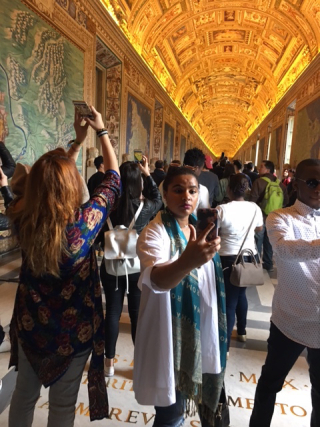 Apart from the obligatory selfies, they were blindly moving to whatever was highlighted by their tour leader or audio guide, so creating more bottle-necks (this isn���t snobbish elitism: the whole thing is set up so that is the only way you can behave). There were very few helpful labels, and no place to sit down (probably strategic to get us out quicker, but I did feel that Jesus would have liked those of us with arthritic knees to enjoy the treasures too). When you came out, the taxi touts were a definite rip off (one fewer man with a gun, I thought, and one taxi dispatcher might have been a good idea).
Apart from the obligatory selfies, they were blindly moving to whatever was highlighted by their tour leader or audio guide, so creating more bottle-necks (this isn���t snobbish elitism: the whole thing is set up so that is the only way you can behave). There were very few helpful labels, and no place to sit down (probably strategic to get us out quicker, but I did feel that Jesus would have liked those of us with arthritic knees to enjoy the treasures too). When you came out, the taxi touts were a definite rip off (one fewer man with a gun, I thought, and one taxi dispatcher might have been a good idea).
Now I can see the museum authorities have real problems and are trying to overcome them (there was a nice new display, with decent signage, of material from Papal excavations, for example). They are struggling with something close to 6 million visitors a year. The Louvre, the BM, the Met and the London National Gallery all have more than that, but unlike the Vatican they were built as public museums in the first place, which gives them a head start. In the face of this, the Vatican���s answer seems more and more rigid control of the visitor���s route, which in many ways makes things worse. They don���t seem to have taken on board that some people (a minority maybe, but still some) do not want to see the Chapel. So we were crammed at snails pace down some narrow stairs and pushed through the place in a fairly unfriendly manner, when we didn���t even want to be there.. The best comparison is a visit to the interior of Lenin���s tomb (but at least you have chosen to go to that).
I don���t have a ready solution and it can���t be easy to find one, though it must be possible. And it must have something to do with loosening up a bit (and maybe providing everyone with a plan).
There���s something close to criminal in sending thousands upon thousands of visitors past some of the greatest works of art in the west and not creating conditions in which they can SEE them meaningfully.
March 15, 2017
To the Vatican
I have been keeping to my resolve in Rome and not emerging from the American Academy except more or less on a ���need to go��� basis. OK the two exhibitions last weekend weren���t actually essential, but apart from that I have left the Academy and its environs only to get two meals down the hill and to go to a lecture by a friend and Cambridge colleague (on the fascist ���disembowelling��� of Rome) at the British School.
Most of my emperors��� work has been in the library. I have finished a chapter and am now trying to get the next two together in my head, with the aim of having some written before I leave. The first of those is about how the image of Julius Caesar has been recognised over the centuries. I am doing this as my first big case study for a number of reasons, including the fact that as Suetonius first ���emperor��� it will allow me to set the historical scene for those readers who feel a bit at sea with the history of imperial Rome.
But there is a bigger intellectual reason for my project ��� namely that the different ways that images of Caesar have been identified (and sometimes gushed over) in the last few centuries are really instructive, and a good illustration of my point that, in terms of identifying emperors, we are not necessarily any better or worse than our predecessors a few centuries ago. In fact what you find is a series of ���favourite ���images of the dictator which hold the scholarly and popular imagination for a generation or so and then fall from grace for some reason (they are judged fake, or some new discovery/rediscovery seems to fit what we are looking for in Caesar better).
So this means that I have to face the Vatican this weekend, where one of those ���favourites��� is I hope happily on display: that is the so-called Chiaramonti Caesar (a type of portrait ��� even if not this example (the similar example in the Palazzo Pitti in Florence seems to have been more influential -- that was much copied from the sixteenth century on in modern Caesar busts). That's him at the top of this post.
I can���t say that visiting the Vatican is my idea of fun. Their attempts to deal with the 1000s who want to see the Sistine chapel, and their unwillingness to make much provision for those who don���t, in their rigorous one way system, has in the past brought out museum rage and a fair bout of anti-clericalism in me. So wish me luck and good temper.
March 12, 2017
Out and About in Rome
I know it is bad form to praise an exhibition that is just about to close, so that no reader can actually go and see it, but that is what I am about to do. Because yesterday, I allowed myself to go out and about in Rome for the first time since I arrived. The truth is, as I have already said, I have been so happy in the library that I haven���t wanted much to step out���. But it was the weekend and there were things to see, and the daughter is also in town.
First stop was the Universal Museum exhibition at the Scuderie del Quirinale (closes today). I wanted to see this because I have long been interested in Napoleon���s confiscations of art from Italy to fill his new Louvre Museum, and a while ago did a bit of work on the fate (and feting) of such sculptures as the Laocoon and Apollo Belvedere in their temporary French home. What this new exhibition did was look at the other end of the story: that is how the Italian works came home from Italy, and what the effects were.
It was a great exhibition for some of the individual pieces on show that had made the enforced trip to Paris and had then been brought back (Raphael���s portrait of Pope Leo X, for example, or Perugino���s extraordinary Imago Pietatis). But there were two big interrelated points that were (almost) being made (I could have done with a bit more explicitation). First was about the return of cultural property, and its effects. What is clear is that the return resulted in tremendous changes in the display of art in Italy, because many of the works of art did not go to the places (often churches) they had been nicked from. But ��� to the chagrin of many of the erstwhile ���owners��� ��� they formed the basis of new civic or national museums. (This isn���t unusual, as the daughter pointed out, contemporary repatriations often raise sharply the question of: to whom the objects in question actually being returned?)
Second, was the claim that I think was the big underlying point of the exhibition: namely, that the idea of Italy as cultural and eventually political unity was kickstarted by expropriations and then return of these objects. The last room featured Canova���s ���Venus Italica��� (crucial epithet, and you see her above) and the series early nineteenth busts of great Italian artists that Canova had sponsored. Risorgimento this way.
As there was time to spare, we then hoofed it to an exhibition that is still running until early May at the Museo di Rome: on Artemisia Gentileschi. This was more crowded in every sense than the Scuderie show (more visitors and more pictures quite close together on the walls). And to be honest I wasn���t quite as capable of concentrating as earlier in the afternoon. But AG���s extraordinary and repeated images of female victimhood and violence were really striking (don���t go to this show if you don���t fancy severed heads, as you see at the very top).
But actually the image that left the strongest impression on me was one of the comparanda, and not by AG herself, sadly. It was Manfredi���s roughly contemporary ���Apollo and Marsyas���. I first caught sight of it from across the room, and didn���t instantly see what was going on. It was the look between the two that attracted me, the young god staring into the eyes of the almost naked, bound Marsyas. It was only when I got close that I saw he had just made the first sado-dispassionate surgical cut into Marsyas��� flesh. Ugh.
The other version: http://www.the-tls.co.uk/out-and-abou...
Mary Beard's Blog
- Mary Beard's profile
- 4104 followers



